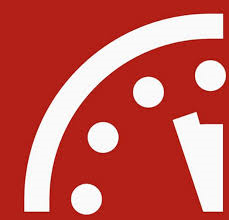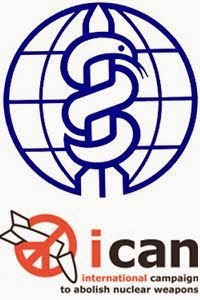By Leonard Eiger
July 16th marks the day 78 years ago when the United States let the nuclear genie out of the lamp.
On July 16, 1945, at 5:29:45 AM at the Alamogordo Test Range, on the Jornada del Muerto (Journey of Death) desert, in the test named Trinity, Manhatten Project scientists detonated the experimental device known as the "Gadget,” creating a light "brighter than a thousand suns." A mere 6 kilogram (13.2 pound) sphere of plutonium, compressed to supercriticality by the surrounding high explosives, created an explosion equivalent to 20,000 tons of TNT (20 Kilotons).
Was this, as thought nuclear physicist Julius Robert Oppenheimer, the beginning of the end? Oppenheimer headed up the Manhattan Project's weapons laboratory at Los Alamos during World War II, and is often credited as the “father of the atomic bomb.”
In a 1965 television interview, Oppenheimer said of the moments following the Trinity test: "We knew the world would not be the same. A few people laughed, a few people cried. Most people were silent. I remembered the line from the Hindu scripture, the Bhagavad-Gita. Vishnu is trying to persuade the Prince that he should do his duty, and, to impress him, takes on his multi-armed form and says, 'Now I am become Death, the destroyer of worlds.' I suppose we all thought that, one way or another."
These scientists had certainly "become death", and they had created what could become (quite literally) "the destroyer of worlds," or what could at least destroy most life on Earth. The nuclear genie was out of the lamp, and now, 78 years later, we may have only one final wish left. What should it be?
Less than one month after the Trinity test, the United States dropped two atomic bombs - on the cities of Hiroshima and Nagasaki - that killing roughly 110,000 people immediately or shortly after the blast. As many as 220,000 were dead by the end of 1945. Even today survivors and subsequent generations suffer the effects of radiation.
The official U.S. government story was that the two atomic bombings were necessary to end the war and prevent up to a million U.S. soldiers' lives should the U.S. invade Japan. Yet, some military and civilian officials have said publicly that the bombings were not necessary to end the war. Even the infamous General Curtis LeMay said, “...The atomic bomb had nothing to do with the end of the war at all.”
What is rarely mentioned about why the U.S. decided to use the bomb (aside from the blatant racism that must have underscored the decision) is that the U.S. intended to intimidate and contain the Soviet Union. Whatever the real reasons, Soviet leader Joseph Stalin “certainly saw U.S. possession of the atomic bomb as a direct threat to the Soviet Union and its place in the post-war world—and he was determined to level the playing field.” And before the radioactive dust had settled the nuclear arms race between the U.S. and Soviet Union was underway.
What is also mostly unknown are the effects on generations of people all over the world from the production of nuclear weapons (by the U.S. and other nuclear nations) - including the mining and processing of uranium, production of the weapons, nuclear testing, and mismanagement of nuclear waste. Generations of human beings have quite literally acted (without their knowledge or consent) as subjects of a grotesque experiment.
So began a journey that has led humanity down the perilous road of continuing preparation for its own destruction. Scientists, continuing the legacy of the Manhattan Project scientists, have continued to seek the power of gods, creating ever more destructive thermonuclear devices over the years; and many in government, industry, and think tanks continue asking for more of these horrific weapons (and their delivery systems).
The U.S. government is currently working to replace its nuclear triad – bombers, land-based s missiles, and ballistic missile submarines, and new thermonuclear warheads will certainly be close behind. The replacement for the OHIO Class “Trident” ballistic missile submarines is currently in production and the Navy hopes to have the first replacement delivered by 2027. The government has already built new bomb-making facilities at Kansas City and Oak Ridge, and is working to upgrade its other nuclear weapons facilities.
The U.S. is so busy boosting its massive nuclear weapons program that it is no wonder it does not support the United Nations Treaty on the Prohibition of Nuclear Weapons. It has paid lip service to the Treaty on the Non-Proliferation of Nuclear Weapons, and has pulled out of both the Anti-Ballistic Missile (ABM) Treaty (President George W. Bush) and Intermediate-Range Nuclear Forces (INF) Treaty (President Donald Trump). To top it all off, in early 2023 Russian President Vladimir Putin announced that Russia was “suspending its participation” in New START, the last remaining nuclear weapons treaty between the U.S. and Russia. Does this sound bleak?
Each successive U.S. president, including Joe Biden, has forged ahead towards nuclear darkness, and it is up to the people to call for an end to this madness that consumes vast quantities of economic capital while preparing for the end of life as we know it; it serves no useful purpose to national security or to humanity.
We, as citizens of the U.S. and as global citizens, can participate on many levels, from advocacy to nonviolent direct action; from our hands to our feet - there is something everyone can do to help to try and put the nuclear genie back in the bottle. It is no simple task, and many people would say that we are naive to think such a thing is possible. Yet, we will never know if we don't try.
Even the U.S. Conference of Mayors has, in many recent years, called on the United States to act now to both prevent nuclear war and eliminate nuclear weapons. This year's resolution by the Conference of Mayors is the first to support specific legislation - House Resolution 77, ‘Embracing the Goals and Provisions of the Treaty on the Prohibition of Nuclear Weapons’.”
Mayors understand that even a single thermonuclear weapon would cause devastation, death and suffering far beyond imagination. The survivors would envy those who were incinerated in the time it takes to snap one's finger, and their cities would be rendered uninhabitable for generations. Now try to imagine the results of a full-scale nuclear war between the U.S. and Russia!
Of course, the U.S. government has known since the early days of the Cold War that a nuclear war would cause the loss of millions of U.S. lives and utter devastation of the nation's infrastructure, and yet it still made plans to deliver the mail, collect taxes, and for Congress to continue whatever business it would conduct after the nation had been destroyed. Much of those plans are still in place. You have to wonder how all this is going to work after an all-out nuclear war.
We have heard time after time that the sole purpose of the U.S. nuclear arsenal is to deter aggression by another nation, and that this doctrine has worked (as there has not been a nuclear war for the past 78 years). Of course they don't talk about the numerous close calls that could have resulted in a nuclear war between the U.S. and Soviet Union/Russia.
Of course, for deterrence to be remotely credible, the U.S. must have the intention to use nuclear weapons, and so long as they exist there is some probability that they will be used one day; it is not about if, but when. As the U.S. Nuclear Declatory Policy states , “As long as nuclear weapons exist, the fundamental role of U.S. nuclear weapons is to deter nuclear attack on the United States, our allies, and partners. The U.S. would only consider the use of nuclear weapons in extreme circumstances to defend the vital interests of the United States or its allies and partners.” The critical question here is, Just what would be considered an “extreme circumstance?”
And finally, as have seen over and over, and now with blazing clarity with Russia's war on Ukraine, deterrence simply does not work. And yet, the U.S. continues to extoll the utility of nuclear weapons to protect itself. It is sheer madness. And now here we are, 78 years since the first atomic device was tested, and we are edging dangerously close once again to a nuclear war between the U.S. and Russia. Such an event would be the end of human civilization, and the survivors would envy the dead.
But we must not stop there. We must get involved with one or more of the organizations – local, regional, national, international – working to abolish nuclear weapons. Above all, we must educate ourselves and then share our knowledge with others so that they can take action.
At 78 years it is high time we put the nuclear genie back in the lamp before it is too late. But first we need to determine what our final wish will be. Let us hope we, as a species, make the right choice. Our survival depends on it.
###
Published at Ground Zero Center for Nonviolent Action on July 17, 2023: https://www.gzcenter.org/after-78-years-can-we-put-the-nuclear-genie-back-in-the-lamp/
















